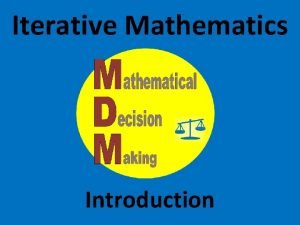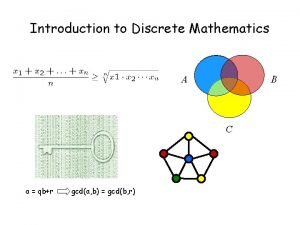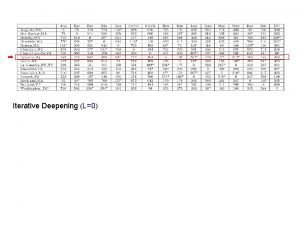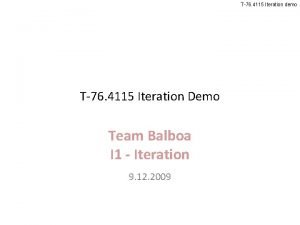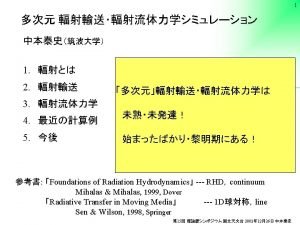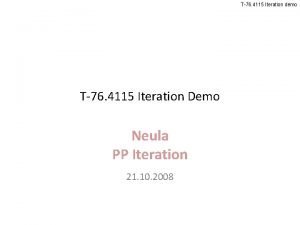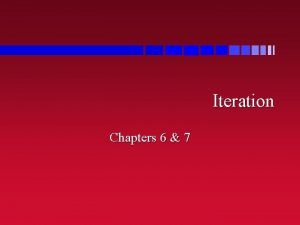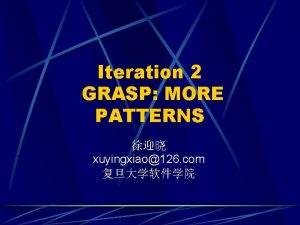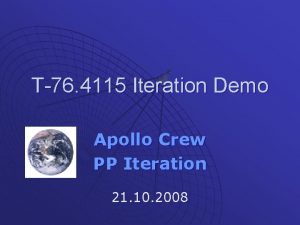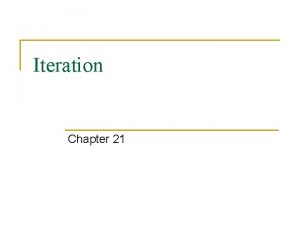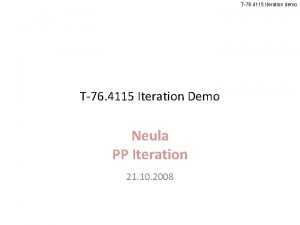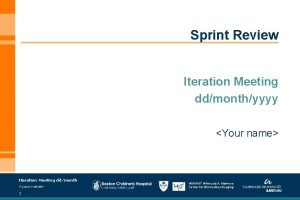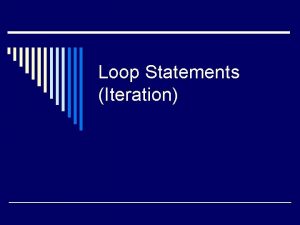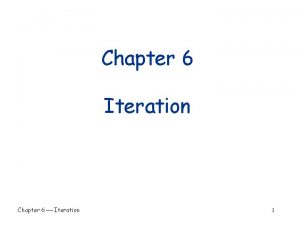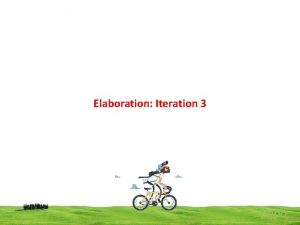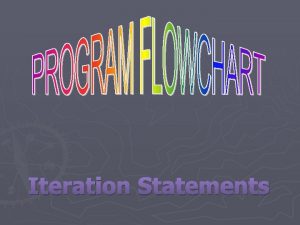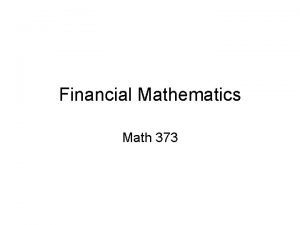Iterative Mathematics Introduction Iterative Math Iteration is the




















- Slides: 20

Iterative Mathematics Introduction

Iterative Math Iteration is the repeated application of a function or process in which the output of each step is used as the input for the next iteration. (This process is also known as recursion) Although iteration in its basic form will not be used to make mathematical complex applications play an Any functiondecisions, that hasmore the same type of mathematical important in decision making(input) research. Weresult will touch on object forrole both its argument and (output) iteration because it is the basis of some of the most exciting can be iterated. Iterations can be done on numbers, and most recent research in mathematics. functions, and geometric figures.

Iterative Math To “iterate” means to repeat; iteration is a repetition of an operation. A nice illustration of an iteration of numbers is the famous Fibonacci sequence. • This sequence is named after Leonardo of Pisa, also known as Fibonacci. • He was one of the most distinguished mathematicians of the Middle Ages. • He is also credited with introducing the Hindu. Arabic number system into Europe.

Iterative Math Every iteration has a starting point and a rule. The Fibonacci sequence starts with the numbers 0 and 1. The rule for the Fibonacci sequence is: to generate the next term in the sequence, add the previous two terms.

Iterative Math So, starting with 0, 1…. The Rule The sequence expands to 0, 1, 1, 2, 3 The next iteration yields 0, 1, 1, 2, 3, 5

Iterative Math So given the first 7 numbers of the Fibonacci sequence, 0, 1, 1, 2, 3, 5, 8, … Expand the sequence to include the first 12 numbers. (5 additional numbers) This recursive sequence will grow infinitely as it expands (diverges). Some recursive sequences settle at a specific number (converge).

Iterative Math In Nature n In the middle of the 19 th century, mathematicians found strong similarities between this sequence and many natural phenomena. n The numbers appear in many seed arrangements of plants and petal counts of many flowers. n Fibonacci numbers are also observed in the structure of pinecones and pineapples.

Iterative Math We can also see Fibonacci numbers in a shallow diagonal of Pascal’s Triangle.

Iterative Math Iterating a function While iterating a function, we pick a starting value as the input and use the function as the rule. Often the idea is to test a function to see if it expands indefinitely (or diverges) or if it settles on a specific number (or converges).

Iterative Math Next, let’s iterate a function. Here’s an example of a very simple iteration of the function . Pick a number, say 0, and put it in for x. (Zero would be considered the input of the function. )

Iterative Math With zero as an input value of we get: 5 is the output value, which we will use as out next input value for the function.

Iterative Math With 5 as the next input value of Now we get: is the output value, which we will use as out next input value for the function.

Iterative Math With 7. 5 as the next input value a calculator may start to become useful. Now 8. 75 is the output value, which we will use as out next input value for the function.

Iterative Math With 8. 75 as the next input value of we get: and so on, and so on…. As the iterations continue, can you guess what will happen to the output value? What if we started somewhere other than zero?

Iterative Math Geometric iterations can be used to describe many structures we see in nature. Let’s look at a fractal tree for example. We will start with one vertical branch (or trunk). The rule for the fractal tree will be wordy, but it in general, it is a simple rule.

Iterative Math The Rule: 1. Copy each branch twice and reduce the length and thickness of each copy by a factor of 2. 2. Rotate one of the new branches 45 degrees and the other -45 degrees. 3. Attach the two smaller branches to the top of the existent branch(s)

Iterative Math The first iteration would look like this. For the second iteration, we will take both of the top branches and follow the rule for each branch. Then we will continue to apply the rules to all of the top branches over and over.

Iterative Math Eventually this tree will fill in. Notice that a leaf has the same structure. As the branches get smaller and smaller, they begin to resemble the veins of a leaf. Although this fractal tree uses a very simple rule, we can see that the structure resembles a real tree.

Iterative Math The fractal tree was drawn using a simple recursive formula (iteration rule). Because such complex figures can be constructed based on such a simple rule, recursion is now used in graphic design that we see every day. One specific example is the recent improvement in the graphics that we see in animated films. Recursion makes it possible to compress data so that small changes in data can not only construct complex figures, but can animate figures so that their movement seems realistic. Like a fern blowing in the wind.

 Iterating in math
Iterating in math Business mathematics chapter 1 ppt
Business mathematics chapter 1 ppt Equivalence truth table
Equivalence truth table Hit the button
Hit the button Hát kết hợp bộ gõ cơ thể
Hát kết hợp bộ gõ cơ thể Lp html
Lp html Bổ thể
Bổ thể Tỉ lệ cơ thể trẻ em
Tỉ lệ cơ thể trẻ em Gấu đi như thế nào
Gấu đi như thế nào Tư thế worm breton là gì
Tư thế worm breton là gì Hát lên người ơi alleluia
Hát lên người ơi alleluia Các môn thể thao bắt đầu bằng tiếng bóng
Các môn thể thao bắt đầu bằng tiếng bóng Thế nào là hệ số cao nhất
Thế nào là hệ số cao nhất Các châu lục và đại dương trên thế giới
Các châu lục và đại dương trên thế giới Công của trọng lực
Công của trọng lực Trời xanh đây là của chúng ta thể thơ
Trời xanh đây là của chúng ta thể thơ Mật thư tọa độ 5x5
Mật thư tọa độ 5x5 Phép trừ bù
Phép trừ bù Phản ứng thế ankan
Phản ứng thế ankan Các châu lục và đại dương trên thế giới
Các châu lục và đại dương trên thế giới Thơ thất ngôn tứ tuyệt đường luật
Thơ thất ngôn tứ tuyệt đường luật
